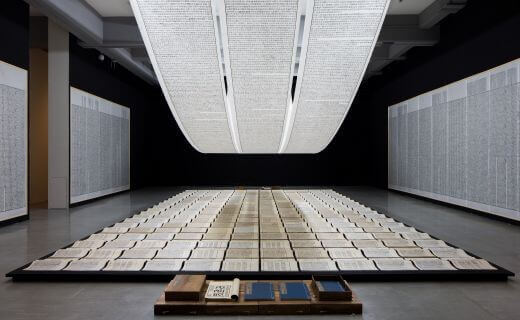Xu Bing: Writing Between Heaven and Earth
Sarah Trudgeon

Xu Bing. Book from the Sky. 1987-91. Installation view: Taipei Fine Arts Museum. January 25-April 20, 2014. Photo courtesy Taipei Fine Arts Museum
Through May 24, 2015
One of my favorite artworks is Xu Bing’s 1st Class (2011), a rug made from half-a-million cigarettes. They stand leaning against each other on the floor to form a 40-by-15-foot “tiger pelt,” the stripes changing from tobacco-brown to filter-orange as you move around the piece. It is about decadence and death and industry and nature—from the history of the tobacco trade to big game—and it’s a perfect balance of all of these, humorous and serious at the same time. I saw it at MASS MoCA, where I stood next to the rug while gazing out over Xu Bing’s Phoenix Project (2007–10), two 100-foot birds made from construction tools and debris, hanging from the rafters of the museum’s stadium-sized gallery.
My best friend (not an art connoisseur, but a writer) jokes that a work of art must satisfy one or more of the following criteria in order to be Art: 1) it required much technical skill, 2) it is very large, or 3) it took a long time to complete. Known worldwide for epic installations that fulfill all three requirements, Xu Bing is one of the most important Chinese artists working today. Xu Bing: Writing Between Heaven and Earth,a 5,000-square-foot exhibition at the Philip and Patricia Frost Art Museum features several of the artist’s iconic installations. In ancient Chinese, the character shu signifies books, written characters, and the act of writing, and Writing Between Heaven and Earth presents the shu art of Xu Bing, four projects that demonstrate the relationship between writing and image—literally, the art of writing.
The centerpiece of the show is Book from the Sky (1987–91), one of Xu Bing’s oldest and most iconic works. A gallery is covered floor-to-ceiling in more than 4,000 illegible Chinese characters the artist invented. He meticulously carved each character into woodblocks and then used them to print enormous wall panels, scrolls that billow from the ceiling, and 160 volumes of books that lie open on the floor like waves. As in most of Xu Bing’s work, a quiet humor is at play: the art of writing ancient Chinese characters is a meditative, holy process. Here, he has blown it out into the absurd. Chinese-speaking people enter the room expecting to be able to read the characters, but find they are unable to do so; people who can’t read Chinese expect that the characters communicate something illegible only to them—when really the characters don’t mean anything to anyone. As Dr. Lidu Yi, curator of the show and professor and historian of Chinese art at Florida International University, told me, “Xu Bing spent four years creating a piece that says nothing.”
This provocation and sense of humor is one of the reasons Xu Bing’s work has had such wide appeal. In one early project, he placed silkworms on various household items, which the worms slowly wrapped in silk; Silkworm VCR (1998) is made up of a VCR full of silkworms, along with a small camera to record their work, which plays on a TV monitor attached to the VCR. The combination of ancient and new, nature and technology, is pure delight. Square Word Calligraphy Classroom (2011),which is installed at the Frost, teaches visitors how to copy “Chinese” characters Xu Bing created out of English letters. A book made out of these characters looks Chinese, but it is actually an English-language book, as if it were wearing a mask. This is a language we don’t have a ready framework for reading, and it both challenges viewers’ perceptions about written language and art, and challenges them to interact with the work by reading it—in a sense, completing it.
Square Word Calligraphy Classroom is actually a classroom, set up in the middle of the exhibition, complete with chalkboard and posters of Xu Bing’s alphabet and low desks stocked with calligraphy brushes, ink, and instructions. “My aim is to make an art that truly serves the people,” Xu Bing has said. In Mustard Seed Garden Landscape Scroll (2010), part of Xu Bing’s Landscape Landscript project on view at the Frost, the artist uses only figures and instructions from the seventeenth-century Chinese painting manual The Mustard Seed Garden, which he has carved, like text, onto woodblocks and then printed on a fifteen-foot horizontal scroll. Nearly every figure in the painting comes with its own tiny instructions printed alongside. This is art that gives itself away.
Reversals and juxtapositions—the inversion of high and low, the combination of holy and absurd, the marriage of different symbolic systems to create something both familiar and foreign—are key to Xu Bing’s work. He constructed Phoenix Project—which was commissioned by a real estate developer to go inside the Caesar Pelli–designed World Financial Center in Beijing—from construction trash and debris lying outside the building and on construction sites across Beijing. Book from the Ground (2003–present), also on view at the Frost, is an interactive staging of two computers running chat software that lures visitors to simultaneously decode universal signs and symbols, a pictographic language that Xu Bing previously developed from preexisting symbols and used to write an entire novel. He says that he “wanted to create a book that anyone in the world could read.”
Dr. Yi explained that when a person cultivates her art and writing, she is cultivating herself in the process. It will do us Miamians some good to cultivate ourselves in Xu Bing’s clever, multicultural, generous image. Lessons in the Square Word Calligraphy Classroom will be offered on Saturdays and some Sundays throughout the run of the exhibition.










